
Toxic Relationship or Supportive Partner? Learning to Love a Scorned Species

Contributor
- Topics: Plants You Need
Fall 2023
Under normal conditions, I do not garden out of spite. But when our absentee landlord jacked up the monthly rent by $700 on my shared San Francisco home, I briefly considered letting vengeance inform my plant choices.
I fantasized about doing some abnormal plant restoration before moving. I had already ripped out enough iceplant (Carpobrotus edulis) to fill a dozen heavy-duty lawn bags, replacing the succulent monoculture with a mosaic of natives such as coffeeberry (Frangula californica), Cleveland sage (Salvia clevelandii), yarrow (Achillea millefolium), and silver lupine (Lupinus albifrons). Perhaps it was time to add a new species to my backyard sand dune habitat: poison oak (Toxicodendron diversilobium).

Though I said goodbye to my nascent restoration garden without launching any passive-aggressive botanical warfare, the idea was triggered. After a friend told me poison oak berries are one of the finest winter food sources for birds migrating through California, I began to reconsider the species as a contribution rather than a curse. My gardening goal at my rental had been to mimic the diversity, function, and elegance of a soft sage scrub ecosystem. Would it make sense to incorporate the ol’ P.O.?
At the very least, including one of the most notorious plants in a landscape plan would earn the intrepid designer major horticultural cred. Bolinas-based native plant restorationist Judith Larner Lowry recognizes this choice is not a popular one. “Poison oak is a hard sell in a small garden,” she admits in her brilliant book, The Landscaping Ideas of Jays (2007), but adds that “the gardener who includes it … is automatically given membership in an elite club.”
Before breaking ground and joining this exclusive affiliation, we should offer poison oak our protracted observation, the kind of appreciative look we hortiphiles love to bestow upon our most celebrated species, for it is as beautiful as it is beneficial. “Its telltale “leaves of three” take on a rainbow of hues depending on season and exposure: from that characteristic cautionary red to a light, matte peach; pale yellow like the weak rays of the autumn sun to a provocative plum; shades of green from peridot to emerald. Though many folks bemoan that California “doesn’t have seasons,” it is these leaves that give California so much of its fall color, the shrubs lighting up the landscape in a blaze of fire-engine red amid dry hills otherwise smothered in golden-brown, invasive grasses. It is these leaves that lend the species its eleven-syllable-long Latinized name, Toxicodendron diversilobium: “poisonous tree” with “different lobes.”
Since most of us try to avoid these leaves, so shiny in spring with an allergen called urushiol (“yoo-ROO-shee-all”) or distinguish its leafless stems of January amid the chaparral’s more benign twigs, it is easy to forget that poison oak is a flowering plant with lovely blossoms to admire. On plants three years or older, a raceme of cream-colored, pale-yellow flowers unfurls around April, each flower with five petals and no bigger than those sugar stars used to decorate birthday cakes. They are full of nectar, fragrant, and one of the few parts of the plant that does not contain urushiol (neither does the berry pulp nor the dried, fallen leaves). If pollination is successful, small, pale-green berries develop in late summer and hang on the branches through early winter.
Yet poison oak’s value extends far beyond its potential aesthetic appeal to the broad-minded human. California’s non-human native fauna have a pivotal relationship with the species. Along with coast live oak (Quercus agrifolia), it may be one of the most important native plants in supporting the state’s unparalleled biodiversity.
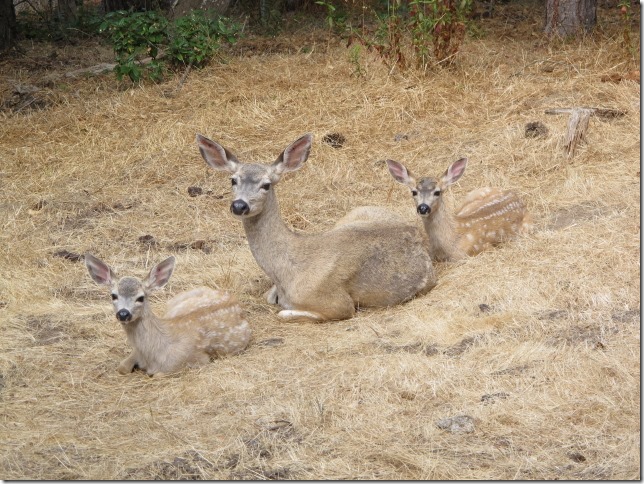
In the 2013 Bay Nature article, “Leaves of Three: The Rash Success of Poison Oak,” authors Ron Sullivan and Joe Eaton detail the interdependency between T. diversilobium and wildlife. Those notorious leaves contain high concentrations of phosphorus, sulfur, and calcium, offering a salad bar for mammals including black-tailed deer, tule elk, wood rats, chipmunks, black bears, and pocket mice. Small mammals and birds take advantage of the dense cover provided by the tangled branches. Both native bees and introduced honey bees collect the copious nectar, especially from the more fragrant male flowers. (For anyone wondering—though poison oak honey is said to be bitter, it is not toxic since the flowers lack the allergen.) Other insects are in on it, too. A survey in the Santa Cruz Mountains recorded 15 insect orders on poison oak. The larvae of numerous moth species eat the leaves and shelter in them when they pupate.
In turn, these insects feed the birds, though it is poison oak’s berries that play a critical role in nourishing our feathered friends. Sullivan and Eaton (2013) offer a lengthy list of the birds that dine on the fruits: quail, turkeys, woodpeckers, corvids, chickadees, bushtits, waxwings, thrushes (including American robins), mockingbirds, thrashers, wrentits, warblers, sparrows, towhees, juncos, and finches. The website of Mendocino County’s Resource Conservation District adds catbirds and grosbeaks to the tally, noting the thickets have been known to hide the nests of the endangered least Bell’s vireo (Vireo bellii pusillus). And of course, the relationship is mutual. Near or far, these winged middlemen disperse the seeds in their phosphorus- and nitrogen-rich droppings, continuing the cycle.
If this spectrum of species could give Yelp reviews, the Leaves of Three Café would receive five stars.
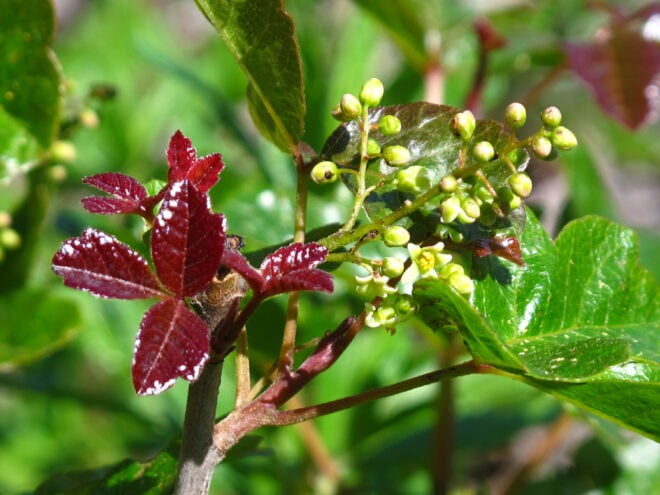
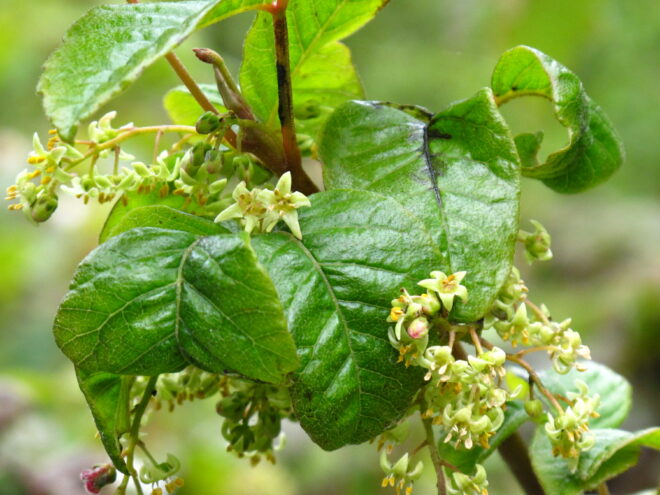
Despite this incomplete catalogue of ecological benefits, I found scant mention of poison oak in my “gardening with California native plants” books. In the more generic but still beloved Sunset’s Western Garden Book, it is conspicuously absent between Tovara virginiana and toyon (Heteromeles arbutifolia—another stellar native plant for wildlife).
Please don’t call me a naif, or insensitive: I am not lamenting this exclusion as one of those lucky 15 percent of folks in the United States not allergic to poison ivy, oak, or sumac. Having grown up romping around the Coast Range’s pokey chaparral, I know the species’ less generous properties well.
Author Lowry (2007) argues that “poison oak is first native plant every California child must learn.” Indeed, I had cultivated my place-based, plant-identifying eye, and a sense of itchy intimacy, throughout my childhood, easily distinguishing its leaves-of-three well before learning my multiplication tables. This awareness rarely stopped me from exploring my wild surroundings. I climbed the neighborhood’s coast live oaks with their poison oak understory; I dug in the ochre-colored sandstone soil laced with roots oozing high concentrations of urushiol. Even as a young adult I still hadn’t learned the lessons seething in the welty red rash and my swollen-shut eyes. More than once, I’d pulled over on Highway 1 in Big Sur to take a hasty “nature pee” only to look down and realize, horrified, I was offering my botanical nemesis a healthy dose of liquid fertilizer.
These days, not only do I possess better observational skills, but I also have a vision of encountering a tenderly nurtured poison oak seedling for sale in a nursery. The fact I never have makes sense. Imagine the courage and devotion of the propagator! Could this reviled species be a prime and realistic nectar, food, and shelter source in California habitat gardens?
The folks at Santa Margarita-based Las Pilitas Nursery don’t think so, a stance that surprised me since their information-rich and laugh-out-loud website tends toward a “plants first” attitude. If any commercial operation were to propagate it, I thought they would be it. Yet as they proclaim on their site, “We do not grow it as we’ve not figured out how to deal with itchy lawsuits” (Wilson 2012). A prudent decision, though they still give props to poison oak’s exceptional habitat value, noting it’s “in the top five for wildlife.”
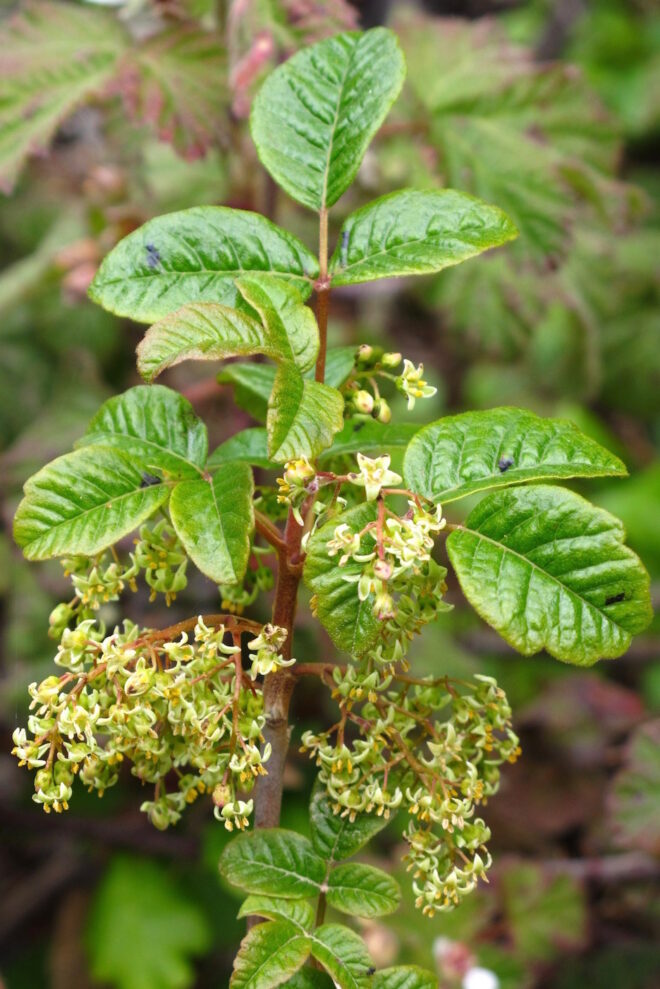
But Lowry’s elite club does have at least one member. Bruce Schwartz, proprietor of LA Native Plant Source (LANPS), might even be its president. An amateur propagator who donates one hundred percent of his proceeds to the Theodore Payne Foundation, at the time of this writing Schwartz had 14 one-gallon containers of poison oak at $9 each in stock at his small operation. On the species description on his website, he asks readers to “step outside the bland uniformity of the typical native garden axis of conventional Manzanita and Ceanothus cultivars” and instead envisage planting poison oak as “an act of radical habitat restoration in your own backyard.”
The renegade restorationist described how he was “retroactively” inspired to grow it after reading Suzanne Simard’s Finding the Mother Tree (2021), a book documenting how the mycelial network improves the health and growth of plant communities. “I like to imagine that planting poison oak in the understory of the coast live oaks on my property (where you would likely find it in the wild in Southern California) is similarly beneficial to the oaks here,” Schwartz wrote.
One of his goals when setting up LANPS was to propagate harder-to-find, lesser-known, threatened, and hyper-local native plant species of particular interest to Los Angeles gardeners who want to offer food and shelter to the megapolis’s wildlife. Though poison oak grows abundantly throughout the state—found in most ecosystems save the desert, and increases with disturbance—once habitat is cleared for human infrastructure, this important species is gone.
Lowry notes that wren tits no longer breed in San Francisco’s South Bay, for example, a break in the cycle that she observes had coincided with the large-scale removal of poison oak.
Schwartz reported that he has, so far, only sold “a handful” of his unusual offerings, mostly “to botany students and serious plant nerds.”
“The common denominator among the people I’ve encountered who are open to the idea of planting poison oak is that they are ‘habitat gardeners’ who recognize that [it] is an undeniable component of a complete, local ecosystem,” he wrote. “As such, they’re willing to work around its allergenic properties, literally and figuratively.” Though he donated several starts for a restoration habitat garden at California State University, Northridge, he heard that the designer’s plan was overruled by his department over liability issues.
And that vulnerability, when it comes down to it, is why intentionally planting poison oak will likely remain a niche endeavor. Michael Chassé, stewardship ecologist for the National Park Service in San Francisco’s Presidio, tells of an instance about 15 years ago when neighborhood groups got angry after a consultant listed the species on a proposed plant list that was made public. He confirms that “the Park does not plant poison oak.” It already grows abundantly in several places in this northwestern corner of the city and, Chassé said, “gets around fine on its own.”
Just because it isn’t planted, however, does not mean it isn’t respected—an attitude shift which might be as equally powerful as poison oak’s habitat value. Chassé mentioned that when the Park has volunteer work groups, they often read a passage from In Full View: Three Ways of Seeing California Plants (1995). Author Linda Yamame marvels at watching deer and how, for them, the plant is “not an enemy, but a sustaining friend.” The volunteers hear that “poison oak [is] … a reminder that we do not always have to be the center, the standard for whom all things are measured.”
Being in the presence of poison oak makes me a more attentive, less self-absorbed human. This feels like essential, desperately needed progress in the modern world. Someday I do hope to have a little container planting of it, at least, far from where I’m liable to ever brush past it. An attempt to settle the score—not with an absentee landlord, but with a landscape that never fails to sustain my body, mind, and spirit.
Resources
Keator, Glenn, Linda Yamane, Ann Lewis. 1995. In Full View: Three Ways of Seeing California Plants. Berkeley: Heyday Books.
LA Native Plant Source. Poison Oak.
Lowry, Judith Larner. 2007. The Landscaping Ideas of Jays: A Natural History of the Backyard Restoration Garden. Berkeley: University of California Press.
Simard, Suzanne. 2021. Finding the Mother Tree: Discovering the Wisdom of the Forest. New York City: Knopf Doubleday Publishing Group.
Sullivan, Ron, Joe Eaton. 2013. “Leaves of Three: The Rash Success of Poison Oak.” Bay Nature. July–September 2013.
Wilson, Bert. 2012. Toxicodendron diversilobum. Las Pilitas Nursery. Modified: January 8, 2012.


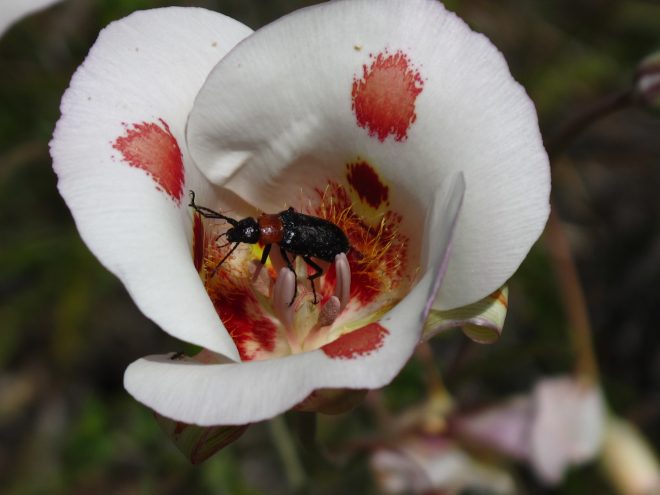








Responses